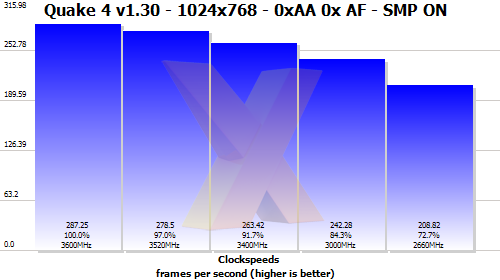Noise no concern and performance scaling
So what if you want ultimate performance and don't care about noise? Well, in that case, keep the fans cranked high and see how far you can go!
With core voltage pushed up to 1.5V in the BIOS, which yielded around 1.45V under full load, we were able to get the Q6700 stable at 3.6GHz. The ASUS P5K Deluxe motherboard also managed to produce the goods, hitting the 1800MHz (450MHz QDR) FSB mark with ease.
Pushing even further, we were able to run benchmarks at just over 3.7GHz, complete with a whopping 1852MHz (463MHz QDR) front-side bus.

At this speed, the processor wasn't stable enough to be used reliably but did allow us to successfully run CINEBENCH.
With sufficient cooling, it may have been possible to get this chip stable at 3.7GHz, with higher voltages, but by this point the Zalman CNPS9700 in our system was being stretched to its limits.
Performance scaling
To see the benefits of our tinkering, we fired up CINEBENCH R9.5 and ran it at a selection of clockspeeds, including the Q6700's stock speed and 9 x 333MHz - the stock speed for the more expensive Core 2 Extreme QX6850.
| Clock Speed | Multiplier x FSB | Memory Speed |
|---|---|---|
| 3704MHz | 8 x 463MHz | DDR2-926, 4-4-4-12 2T |
| 3600MHz | 8 x 450MHz | DDR2-900, 4-4-4-12 2T |
| 3520MHz | 8 x 440MHz | DDR2-880, 4-4-4-12 2T |
| 3400MHz | 8 x 425MHz | DDR2-850, 4-4-4-12 2T |
| 3000MHz | 9 x 333MHz | DDR2-800, 4-4-4-12 2T |
| 2660MHz | 10 x 266MHz | DDR2-800, 4-4-4-12 2T |

CINEBENCH exhibits strong performance improvements with overclocking. However, being almost entirely CPU-limited, it also represents a near best-case scenario for CPU scaling with overclocking.
Quake 4 v1.3 proved too much for our Q6700 to handle at 3.7GHz. The settings used to run CINEBENCH would crash the game mid-run and increasing voltages further caused heat to rise - resulting in Windows failing to boot.

At 1024x768, with no anti-aliasing or anisotropic filtering, the GeForce 8800GTX is barely being challenged.
Quake 4 clearly relishes the extra clock and front-side bus speed, with an increase of more than 30fps just from moving up to 3GHz. An increases to 3.6GHz sees an improvement of almost 80fps over stock speed.
Games running at higher resolutions that are bottlenecked by the GPU - or applications that are I/O limited - will not see such linear increases in performance. There is, however, clearly a huge amount of processing muscle on display here .









